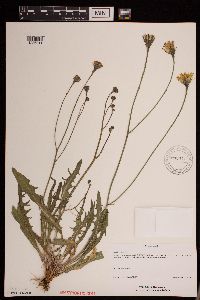Leontodon autumnalis
|
|
|
|
Family: Asteraceae
|
Perennials, 10-80 cm. Stems 1-20 +, decumbent, scapiform, usually branched distally, glabrous proximally, tomentose proximal to heads. Leaves: blades narrowly oblanceolate, 4-35 × 0.5-4 cm, entire to deeply dentate or lobed (lobes narrow, straight or slightly recurved), faces glabrous or hirsute, hairs usually simple. Heads (1-)2-5 in loose, corymbiform arrays. Peduncles bracteate proximal to heads. Calyculi of 16-20, narrowly triangular to subulate bractlets 2-4 mm, tomentulose. Involucres campanulate, 7-13 × 8-10 mm. Phyllaries 18-20, narrowly lanceolate, 10-12 mm, subequal, glabrous, sparsely tomentose, or coarsely hirsute. Florets 20-30; corollas deep yellow, 13-16 mm. Cypselae cylindric or fusiform, 4-7 mm (not beaked); pappi wholly of yellowish white or tan, plumose bristles 5-8 mm. 2n = 12, 24. Flowering Jun-Oct. Roadsides, pastures, open fields; 10-1300 m; introduced; Greenland; N.B.; Nfld. and Labr. (Labr.), N.S., P.E.I., Que.; Alaska, Conn., Idaho, Iowa, Maine, Mass., Mich., N.H., N.J., N.Y., Ohio, Oreg., Pa., R.I., Vt., Wash., W.Va.; Eurasia. Leontodon autumnalis is recognized by the usually branched stems with (1-)2-5 heads, peduncles bracteate proximal to heads, non-beaked cypselae, and pappi wholly of plumose bristles. It is now established in eastern North America and is sporadic in the west. Specimens with coarsely hirsute phyllaries have been recognized as var. pratensis; intermediates occur and the characteristic does not seem to correlate with other characters.
Fibrous-rooted perennial from a short caudex or crown; scapes 1-8 dm, commonly decumbent at the base, scaly-bracted at least above, ordinarily branched, commonly tomentose-puberulent at the summit, otherwise glabrous; basal lvs oblanceolate, 4-35 נ0.5-4 cm, glabrous or moderately hirsute, deeply, narrowly, and rather distantly lobed to occasionally entire; heads terminating the branches; invol 7-13 mm, with narrow, imbricate bracts, scarcely elongating in fr; achenes fusiform-columnar, not beaked, weakly nerved, transversely rugulose, 4-7.5 mm; pappus wholly of plumose bristles, these chaffy-flattened at the base; 2n=12, 24. Roadsides, pastures, fields, meadows, and waste places; native of Eurasia, now established from Del. to Greenl. and inland sometimes to Wis. June-Oct. (Apargia a.) Var. autumnalis has the invol merely tomentose-puberulent to glabrous. Var. pratensis (Less.) Koch, more boreal, has the invol also spreading-hirsute. Gleason, Henry A. & Cronquist, Arthur J. 1991. Manual of vascular plants of northeastern United States and adjacent Canada. lxxv + 910 pp. ©The New York Botanical Garden. All rights reserved. Used by permission. |



































































































